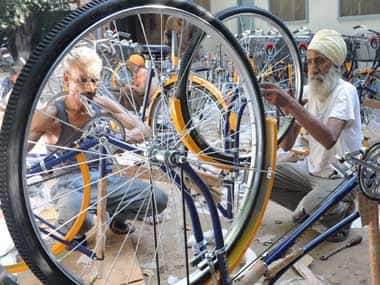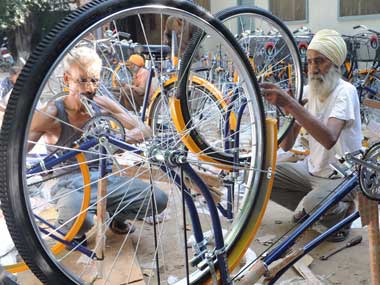Noted environmental activist Sunita Narain was cycling on Delhi’s streets on a calm Sunday morning from her residence to Lodhi Road when she was struck from behind by a speeding car near the AIIMS flyover. Conscious, despite a broken nose and arms, the environmentalist managed to get a lift from another vehicle which took her to AIIMS. After eight hours of surgery and having titanium plates inserted in her hands, she had one thing to say on Monday,“Cyclists in Indian cities are being edged out systematically to make way for cars.” The Delhi police has said there have been 67 cyclists who have been killed in the national capital this year and an NDTV article quoted traffic police officials as saying that they will swing into action to ensure the safety of cyclists. [caption id=“attachment_1184865” align=“alignleft” width=“380”]  Representational image. AFP[/caption] Their solution? Ensuring safety stickers are put on the mud guards of one lakh cycles by the year end so that the glow from them will warn motorists that there is a cyclist ahead. The problem is even if Sunita Narain did have a safety sticker on a cycle it wouldn’t have done her much good given visibility couldn’t have been too bad on the road when she was cycling. We don’t know if the environmentalist’s cycle already had better safety equipment than the Delhi police plans to provide. And given cycles are not registered it’s also not very clear how the Delhi police plans to ensure every cyclist in the capital has a safety sticker in place. But then cyclists in India have never truly been safe on India’s roads. A cursory glance at the World Health Organisation data for road fatalities across the world shows that only about 5 percent of India’s cyclists are involved in fatal accidents. Here’s how India ranks compared to some other countries based on 2010 data:
Create infographicsCompared to Serbia, India seems like a safe place to take out your cycle but unfortunately the devil lies in the numbers. While just around 66 persons die annually in Serbia, in India that number is a whopping 6696 deaths. Urban centres have attempted to provide for the safety of cyclists in different ways. In Mumbai and Delhi, cyclist lanes were provided that were quickly encroached on by pedestrians who are as low on priority for urban planners as cyclists. If the pedestrians don’t get to it, parked vehicles do. “Wherever in India I have seen cycle lanes they are there only for short distances and they mostly have people walking in them. You’re then forced to get back on the road,” Hitisha Mehta, a Mumbai-based architect and regular cyclist, told Firstpost. Mehta, who cycles approximately 75 kilometers daily when she sets off from her house Tardeo in south Mumbai to the northern suburb of Dahisar and back, said that despite wearing all the safety gear possible she rides very carefully. “Car owners these days don’t seem to be bothered… I wear safety gear and ride carefully so that I don’t give them a chance to claim that the cyclist was irresponsible,” she said. While some like Mehta are willing to brave the roads and get by on their bikes, in some cities like Bangalore, cyclists have reportedly preferred to hang up their wheels for safer alternatives. In Kolkata, the Mamata Banerjee government banned cyclists from main roads altogether ensuring their safety. Ironically enough, cycle travel was most popular in the city among the four metros. The WHO in its data on road safety points to the fact that India is among the nations where there is no comprehensive speed laws. And as any motorist in India knows most traffic laws can be easily be circumvented without fear of any drastic reprisal. Like most deaths due to road accidents, the enforcement of traffic laws and driver etiquette is key. With what can be best described as a lackadaisical attitude towards enforcement of traffic rules, no matter the conveniences provided, cycling in urban areas will remain a dangerous prospect. Sunita Narain finally may be one of the luckier cyclists on Indian roads to have survived a road accident and to have not become another statistic. But for those either compelled to use a cycle, or those like Mehta who cycle because they enjoy it, its just another sign that just staying to the side of the road while riding doesn’t ensure their safety.


)
)
)
)
)
)
)
)
)



